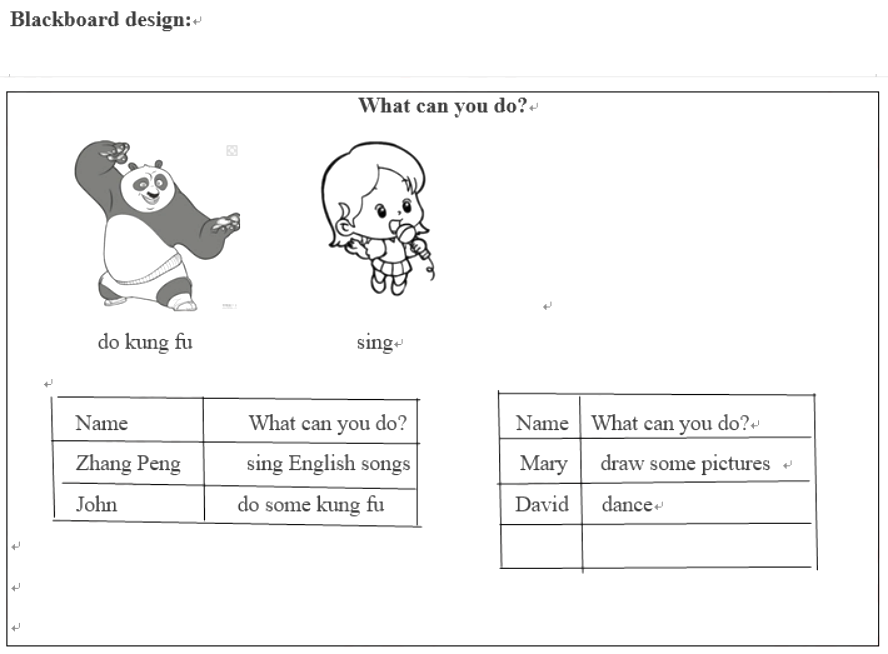你能教我英语吗?Can you_______ _______English?
题目
你能教我英语吗?
Can you_______ _______English?
相似考题
参考答案和解析
55.teach me
更多“你能教我英语吗?Can you_______ _______English? ”相关问题
-
第1题:
在校研究生能报考英语四级吗
可以啊。
-
第2题:
英语四六级在职人员能考吗我今年28 大学毕业六年了 还能在考英语四六级吗
不能了,社会上不承接四六级考试了。你如果不是在校生的话可以去考公共英语。PET
-
第3题:
你们每天都运动吗?
Do you_______ _______every day?
正确答案:
50.play sports -
第4题:
你能更多的说一说英语中升降调的规则吗?答案:解析:在刚才的试讲中涉及到了陈述句、一般疑问句和特殊疑问句的在口语中运用的音调规则。实际上在真实的交际中找到更多的规则,在读选择疑问句和反义疑问句时应前升后降;
感叹句应读降调;当未听清对方的话,要求对方重复一下用升调;陈述疑问句也要用升调;在祈使句中表示命令的用降调,表示请求的用升调等等。
其实学习英语语音是一件很有趣的事情,老师在语音教学中应把知识融入到真实的生活场景中,激发学生的学习兴趣,从而达到新课标要求的培养学生综合运用能力。 -
第5题:
“Can you tell me what beef is used for grilled mixed grill?”这句话的意思是()。
- A、你能告诉我铁扒外脊扒用什么牛肉吗?
- B、请你告诉我铁扒个脊扒需要用什么原料。
- C、你能告诉我铁扒杂拌怎样做?
- D、你能告诉我铁扒杂拌用什么牛肉吗?
正确答案:D -
第6题:
“你要车吗”的常用英语对答是"Do you want a taxi?"()
正确答案:正确 -
第7题:
我能帮助您吗?用英语最妥当的表述是()。
- A、Can I have any assistance?
- B、Can I help you?
- C、Can I beany assistance?
- D、Can I be of some assistance?
正确答案:B -
第8题:
Can you tell me how to use the foam extinguisher? ()
- A、你能告诉我怎样使用干粉灭火器吗?
- B、你能告诉我怎样使用泡沫灭火器吗?
- C、你能告诉我怎样使用二氧化碳灭火器吗?
- D、你能告诉我怎样使用便携式灭火器吗?
正确答案:B -
第9题:
He()us English.(他教我们英语。)
- A、teachs
- B、teachies
- C、teaches
- D、tiachves
正确答案:C -
第10题:
问答题现在有很多留学生和中国学生互助互学,“你教我英语,我教你汉语”,对这种学习方法你是怎么看的?(2.5分钟)正确答案:
互助互学这个方法,我觉得挺好,既结交了朋友,又能帮助大家提高外语水平。我们知道学习外语除了在课堂上努力学之外,更多的是课后不断地练习。现在的语言培训机构收费也挺高,对学生来说这是一笔不小的花费。如果留学生和中国学生互助互学,对留学生来说,一方面可以结识更多的中国朋友,另一方面也省了一笔花费,还能有更多的练习汉语的机会。而对中国学生来说,也有了练习口语的机会。这是一个对双方都有剩的好方法。解析: 暂无解析 -
第11题:
单选题We can't help you_______ you tell us what's wrong.Asince
Bunless
Cif
Dwhen
正确答案: A解析: -
第12题:
填空题你最好买一本英语词典。____ buy an English dictionary.正确答案: You’d better解析:
had better do“最好做…”。 -
第13题:
有什么事我可以为您效劳吗用英语最妥当的表述是( )。
A.Is there anything I can do for you
B.Is there something I can do for you
C.Are there any things I can do
D.Are there something I can do
正确答案:A
-
第14题:
英语四级以前考试的能查吗
不能。四级往次的成绩是不能查询的,只提供当次成绩查询。去年前年的是肯定不能查了。现在只能看下你们学校教务处是否存档。
-
第15题:
你能告诉我怎样使用这个照相机吗?
Can you tell me_________ _________use the camera?
正确答案:
33. how to -
第16题:
小学英语 听说
一、考题回顾
题目来源:5月19日 上午 湖南省常德市 面试考题
试讲题目
1.题目:What can you do?
2.内容:
Miss White: We’ ll have an English party next Tuesday? What can you do for the party, children?
Zhang Peng: I can sing English songs.
Miss White: Wonderful! How about you, John?
John: I can do some kung fu.
Miss White: Thank you, John.
3.基本要求:
(1)十分钟试讲
(2)适当板书
(3)设计听力教学活动
答辩题目
1. 谈谈你的教学目标。
2. 如何提高学生的听力水平?答案:解析:二、考题解析
【教案】
Teaching aims:
Knowledge aims:
Students can know how to ask others’ ability by using the sentence pattern “what can you do”.
Students can know how to answer others’ questions about ability by using the sentence pattern “I can...”.
Ability aim:
Students can improve their intensive listening and extensive listening ability.
Emotional aims:
Students can increase their confidence in speaking English.
Students will have the strong will to improve their ability.
Key and difficult point:
Key point: Students can improve their listening about asking and answering the ability.
Difficult point: Students can use the sentences in their daily life and improve their interests in learning English
Teaching procedures:
Step 1: Warming-up
1. Greetings. Talk about the weather.
2. Share a tongue twister with the students.
Can you can a can as a canner can can a can?
Ask students what word they hear in the tongue twister. They may answer the word “can”. Then tell students today we will learn more about “can” and the title is “what can you do?”.
Step 2: Pre-listening
1. Show students the picture about students’ ability like singing and doing kung fu. Then ask the students to predict what they can do. Students may answer they can sing and they can do kung fu. Then let students to listen to the tape and check whether their prediction is right.
Step 3: While-listening
1. Extensive listening
Ask students to listen to the tape for the first time and answer two questions “How many students are there in this conversation and who are they?” and “What can they do?”. Then write down the names and sentences on the blackboard.
2. Intensive listening
Listen to the tape for the second time and ask students to fill in the table on the blackboard. Then invite some of them to finish the table and check it.

Step4: Post-listening
Ask students to do a survey about what they can do. Four students in one group. Five minutes will be given. Then invite the group leader to do the report. The teacher retells one piece of detailed information from the report and gives encouragement.
Step5: Summary and Homework
Summary: The teacher and students summarize what we have learnt in this class together.
Homework: Draw the pictures according to the sentence pattern “I can...” we have learnt today. And share it next class.

【答辩题目解析】
1. What are your teaching aims?
【参考答案】
My teaching aims are three-dimensional, including knowledge aim, ability aim and emotional aim.
Firstly, my knowledge aim is that students can know how to ask and answer the topic about one’s ability by using the sentence pattern “what can you do” and “I can...”.
Secondly, my ability aim is that students can improve their intensive listening and extensive listening ability.
Thirdly, my emotional aims are that students can increase their confidence in speaking English and that students will have the strong will to improve their ability.
【答辩题目解析】
2. How will you improve the students’ listening ability?
【参考答案】
Listening ability is the long-term training. To improve students’ listening ability needs plenty of listening training and effective guidance.
First, I will give students the specific guidance in different listening material. For example, I guided students to pay attention to the answer of the question sentence to get the idea.
Second, I will try to play the tape for students every class, so that students can have more chances to hear the native English. The more they listen, the more they will be familiar with the English accents. -
第17题:
“Can I help you?”的中文意思是:()。
- A、要我帮忙吗
- B、你能帮助我吗
- C、你好
- D、对不起
正确答案:A -
第18题:
如果要问“有人应价吗?”你可以用英语简单的表达为()?
正确答案:Any bid -
第19题:
“Would you please tell me how to cook grilledcod?”这句话的意思是()。
- A、你高兴告诉我这是什么鲑鱼吗?
- B、你高兴告诉我铁扒鲑鱼怎样做吗?
- C、你能教我怎样做铁扒鳕鱼吗?
- D、你能教我怎样做铁扒外脊扒吗?
正确答案:C -
第20题:
DOES HELMSMAN UNDERSTAND ENGLISH?的中文意思是:舵工懂英语吗?
正确答案:正确 -
第21题:
判断题DOES HELMSMAN UNDERSTAND ENGLISH?的中文意思是:舵工懂英语吗?A对
B错
正确答案: 错解析: 暂无解析 -
第22题:
名词解释题英语(English)正确答案: 是由古代从北欧及斯堪的纳维亚半岛移民至大不列颠群岛的盎格鲁、撒克逊和朱特部落的日耳曼人所说的语言演变而来,并通过英国的殖民活动传播到了世界各地。解析: 暂无解析 -
第23题:
单选题Can you tell me how to use the foam extinguisher? ()A你能告诉我怎样使用干粉灭火器吗?
B你能告诉我怎样使用泡沫灭火器吗?
C你能告诉我怎样使用二氧化碳灭火器吗?
D你能告诉我怎样使用便携式灭火器吗?
正确答案: B解析: 暂无解析
